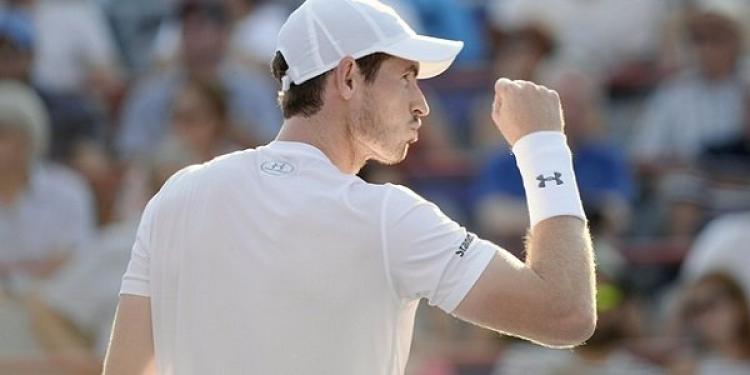Andy Murray: Consistently One of the Best in Men’s Tennis
Posted: August 26, 2015
Updated: October 6, 2017

Andy Murray can win whenever he decides to.
Andy Murray defeated Novak Djokovic to win the Roger’s Cup and made gambling news. Although the Briton has won the tournament in two-consecutive years, it occurred before Djokovic’s streak against him. Murray’s win only gives him nine wins to Djokovic’s 19 over him. Murray was able to give the world number one his fourth loss in 56 matches all year. Andy has secured his place as world number two, taking over Roger Federer’s position.
● Holds the record for the most Australian Open finals appearances
● 6th player in history to make over USD 30 million in prize earnings
● First defeated Rafael Nadal on clay at the 2015 Madrid Masters
To win the Roger’s Cup, Murray defeated JoWinefred Tsonga, last year’s winner, in straight sets. In addition, he defeated Japan’s Kei Nishikori and destroyed Nishikori odds for this tournament and possibly the next. Murray proved once again his capabilities for great tennis can even exceed his own self-doubt. Let’s look at what makes up the fiber of this irregular tennis sensation.
Andy Murray has shown consistent play

Murray first played tennis at three years old and entered his first tournament at five. The secret to the Briton’s success is consistency in tournament play. Unfortunately, that consistency is limited to his high placement in tournament instead of victories. In his career Murray has only won two Grand Slam titles. When he was 15, Andy went to Barcelona to train at the Sanchez-Casal Academy.
Andy Murray was born with a bipartite patella which wasn’t diagnosed until he was 16. This condition made it challenging for Murray to play at times. During junior tennis competition Murray was considered extremely competitive. After winning the prestigious Orange Bowl competition, Murray played in the Challenger and Futures circuits. He was able to secure victories in Glasgow, Xativa and Rome. The pinnacle of his juniors career was when he won the Junior U.S Open.
With a world ranking of 407, Murray ventured onto the professional tour. Although he was the youngest Briton to play in the Davis Cup, he didn’t win an ATP match until he played at the Queen’s Club Championships on a wild card selection. Progressing to the third round, Murray qualified for another wild card for Wimbledon. At Wimbledon the Briton made it to third round and his first US Open appearance resulted in a second round loss. Murray may not have been fit for those using online sportsbooks in the UK.
Andy Murray finally progressed to his first ATP final at the Thailand Open. Facing world number 1 Roger Federer, Murray lost in straight sets. In 2006, he had his first full professional year where he was able to reach the fourth round at Wimbledon and the US Open. Murray was also reached his first ATP Masters semi-final at the Roger’s Cup. In Cincinnati, the Briton broke Roger Federer’s 55 match winning streak and became one of two players to beat the Swiss number one all year.
Andy Murray’s future became brighter
In 2007, Murray had a forgettable year due to readjustments and injury. Having split with his coach of one year, Murray hired a group of experts and a main coach. The Briton reached the fourth round of the Australian open and the third round of the U.S. Open. During match play in Hamburg, Murray hit a forehand and tore some of the tendons in his wrist. Despite this, he won two titles in San Jose and St. Petersburg.
The following year, Murray was able to reach the US Open final where he was defeated by Roger Federer. The Briton won his first and second Masters shields in Cincinnati and Madrid qualifying in for the Masters Cup. Victories in Doha, Marseille and St. Petersburg helped him reach world number four. In 2009, Murray won again at Doha and Rotterdam. His numerous appearances in the upper rounds of tournaments earned Murray a world number three ranking, the highest ever for a Briton in the open era.

Apart from his two Masters wins, Murray’s only high point was his 2010 finals appearance at the Australian Open. This was the first year Murray seriously considered retirement. The following year Murray replicated the same success, but was ranked world number five. In 2012, the Briton won his first Grand Slam at the US Open. As a result he was the first Brit to win since 1936 and the first Scotsman winner since 1896. The final match against Novak Djokovic broke the record for the longest tie break in US Open history at 12-10.
The following year, Murray won his only other Grand Slam at Wimbledon. After surgery, 2014 proved to be unimpressive due to Murray’s recovery. In 2015, Murray’s ranking moved from number five to number two. The Briton did win his first titles on clay. The Madrid Masters proved influential since it was his first victory over Nadal on clay. After two semi-final appearances at the French Open and Wimbledon, Murray won his third Roger’s Cup title beating Djokovic in the final.
Murray was the first British player to win an Olympic medal in 100 years. The Briton made seven Grand Slam finals appearances. In addition, he held the record for the most Australian Open finals appearances at four. Murray was the seventh player to reach the quarter finals of all four Grand Slam majors in a calendar year. Due to his consistent accomplishments in tournament play, Murray has made close to 40 million dollars in prize money. Andy is nowadays a much safer bet for punters waging through mobile betting.











